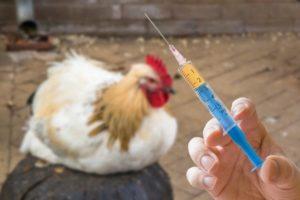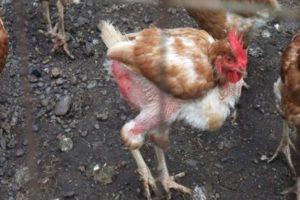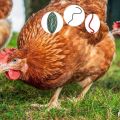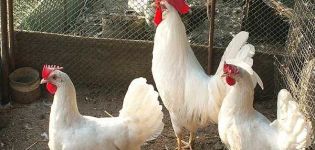Is it possible to keep domestic chickens and turkeys together
Planting several types of poultry in the backyard, the poultry farmer is tempted to collect it in one room. This significantly saves money, since one common house is built, and it is easier to care for the livestock. Further information on whether it is possible to keep chickens and turkeys together, and what conditions the feathered wards will have to create for a comfortable existence.
Is it possible to keep chickens and turkeys together
Both bird species belong to the same family, Pheasant. Chickens and turkeys are terrestrial birds with common habits, similar feeding patterns and requirements for warmth and light. They may well get along in the courtyard in the same room.
Advantages and disadvantages
The main advantages of the joint keeping of land birds include:
- savings on the construction of one common room, instead of two separate ones;
- saving space on the site, because one common aviary is also being built for the bird;
- it is easier and faster to look after the livestock.
Experienced poultry farmers call the main disadvantages of the joint settlement of chickens and turkeys the susceptibility of turkeys to diseases that are common to all chickens.
Keeping turkeys requires careful observance of sanitary standards and regular intake of medications for prevention.
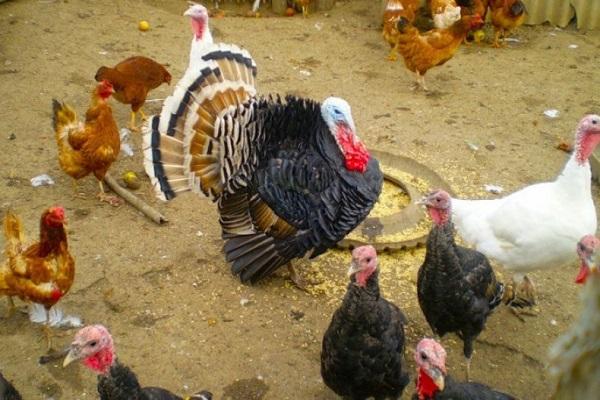
The joint keeping of turkey poults, especially modern meat crosses, together with chickens, is not allowed. Chickens can carry disease without getting sick themselves.
The lack of a common room for poultry includes the difference in the size of the birds. And although turkeys are rarely pugnacious and do not offend chickens, large individuals require more food. If you do not correctly calculate the feed requirement of the entire livestock, turkeys can "eat" chickens, taking food from them according to the "right of the strongest".
Joint keeping of chickens and turkeys
If the poultry farmer decides to settle the wards in the same room, it is necessary to think over how to do this with the least damage to the bird and the maximum benefit for himself.
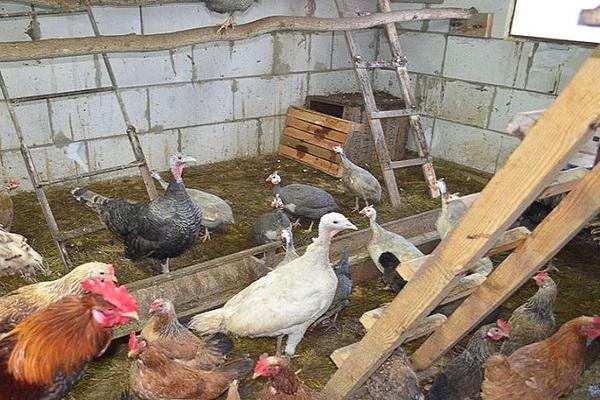
Breed selection
You should not add heavy meat breeds of turkeys to chickens. This bird is extremely capricious and requires a special approach to keeping. Turkeys of egg and meat-bearing (medium-heavy) breeds get along well with chickens: Tikhoretsk, Moscow white, North Caucasian.
It is better to settle chickens with turkeys large - meat and meat-and-meat (Kuchinsky, Amroks, Orpingtons, Orlovsky calico, Australorp).

The necessary conditions
Chickens and turkeys alike need warmth and dryness. The comfortable temperature for the bird is from +15 to +27 degrees. Drafts and dampness are avoided.Large wood shavings, straw cutting, hay, fallen leaves are used as bedding in the poultry house.
The area of the chicken coop is calculated based on the number of poultry kept there. One adult chicken should have at least 50 square meters. cm, for a turkey at least 80 sq. cm. It is advisable to make the outdoor enclosure spacious (at least 2 square meters for one large individual) so that the bird can run.
Perches and nests are built taking into account the dimensions of the turkeys. The thickness of the perch bar should be at least 5 cm, and the size of the nest 50 by 60 cm.
Feeders are selected in such a size that it is convenient for the turkey to eat food, but they are placed at a height that is comfortable for the chickens.
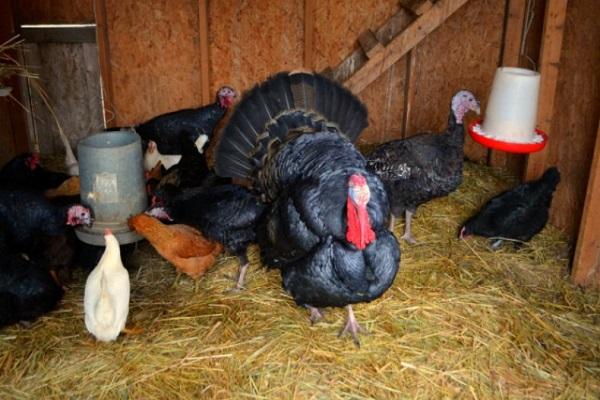
Power features
The diet of chickens and turkeys consists of grains, vegetables, herbs and animal supplements. The bird should be given mineral feed and vitamins.
If we compare the indicators of the ready-made complete feed for adult turkeys and laying hens, then the metabolic energy in the feed for turkeys will be more than 260 kcal, crude protein 18%.
Chicken compound feed has a similar composition, from which it can be concluded that an adult bird can be fed with the same composition of the grain mixture. However, during the young growth stage, turkey poults need more nutritious and fortified feed than chickens.
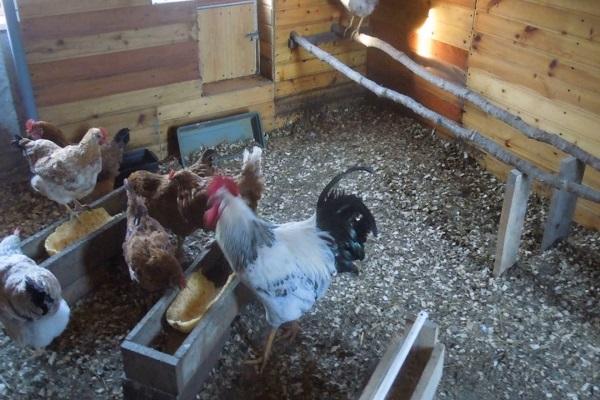
Chicken
Chickens can be fed with ready-made feed or prepare the grain mixture yourself. The basis of the mixture includes corn, wheat and barley in equal proportions. To make it better absorbed, the whole grain is crushed or flattened. The daily grain consumption rate for an adult is 130-150 g.
To the grain mash add:
- sunflower cake, fuzu, meal;
- dairy products (reverse, whey, yogurt);
- meat and bone meal and fish meal, boiled meat or fish;
- fresh vegetables (carrots, pumpkin, beets, cabbage);
- grass or hay cutting, grass meal;
- premix or BMVD;
The total amount of additives should not exceed 25-30% of the volume of the entire mash. Wet food is given to the bird 2-3 times a day in such a way that the food is eaten within an hour. Chalk, limestone, crushed eggshells, charcoal, red clay are placed in a separate feeder.

Turdyukov
For adult turkeys, the menu described above is suitable.
The daily grain rate for an adult bird depends on the weight of individuals and is 200-400 g.
Turkeys graze well and consume a lot of greens (up to 50% of the total food intake). Fresh grass of legumes, tops of garden plants (carrots, beets), vegetables should be present in the diet every day. An adult turkey eats greens up to 600 g per day. In winter, fresh grass is replaced with grass flour, hay cutting.
Separately, it should be said about feeding turkeys from the first days of life. Babies up to a month need a very nutritious food, with an energy content of 1200 kJ and a protein indicator of 28%, crude fiber should be about 5%.
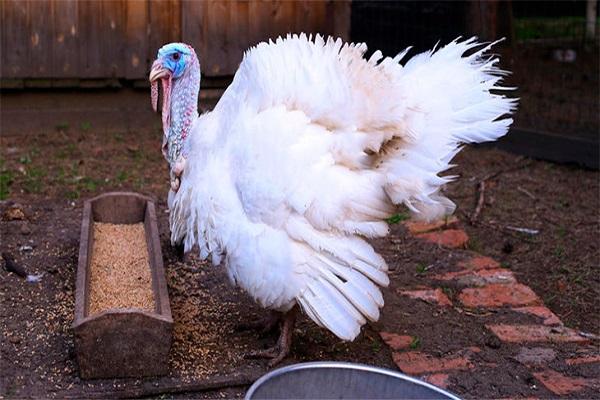
It is difficult to prepare such food at home. To do this, you will need to mix corn, wheat and sunflower cake in equal proportions, add milk powder, feed yeast and grass flour, chalk and the BMVD complex. It is much more convenient to feed turkey poults with ready-made complete feed "Start".
Starting from 30-40 days, young animals can be gradually transferred to a grain mixture (corn and wheat), with the addition of vegetables, herbs and animal products.

Problems with sharing birds
The joint keeping of turkeys and chickens can lead to obesity of the latter, since the feed will be given with the expectation of larger individuals. An overweight chicken stops laying and may die from heart failure. To avoid such a development of events, it is necessary to accurately calculate the daily rate of grain feed for all poultry and strictly adhere to the dosage.Food is given 2-3 times a day, in small portions.
It will not work to distinguish between nesting chickens and turkeys in one room. Although turkeys have nest boxes on the floor and chickens can hang their nests higher, it will not work to get chickens to lay their eggs in certain nests. Laying hens will inevitably throw eggs into turkey nests, and those with their weight can simply crush the chicken clutch. The way out can be the frequent collection of eggs or the arrangement of special nests, where the eggs, after being laid, will roll into the shelter.

The joint keeping of chickens and turkeys threatens the occurrence of diseases common to these species. Enterohepatitis, histomonosis, coccidiosis are especially dangerous. The poultry farmer will have to regularly feed the birds with medications for prevention and keep the poultry house perfectly clean.
However, young chickens and turkeys must not be kept together until they are 3 months old.
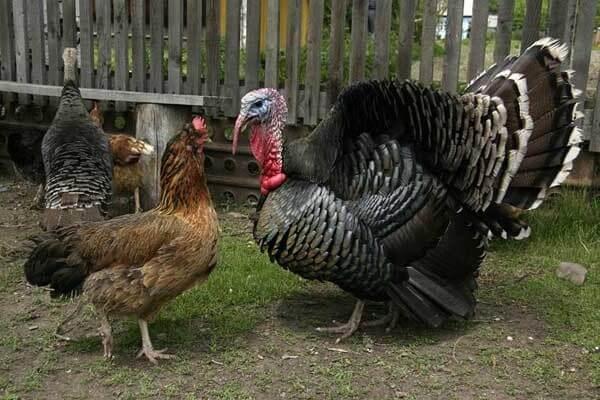
Features of the content in winter
Adult turkeys are quite unpretentious creatures and, along with chickens, willingly walk outside on fine winter days. In order for the bird to compensate for the lack of movement in bad weather, cabbage heads, brooms of grass and young shoots of trees are hung in the shed so that the bird jumped up, trying to peck on the delicacy.
The house should be warm, light and dry in winter. It is necessary to comply with the bird planting rate, avoiding overpopulation.
With a crowded content, fights and pecking often occur, the immunity of the livestock decreases.
